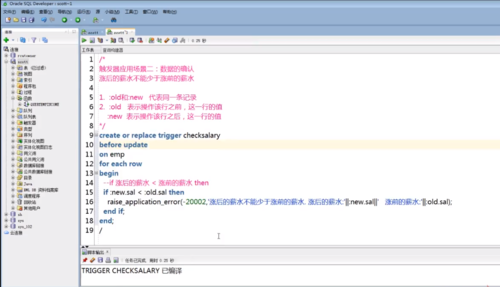-

- 慕设计4302654 2021-11-09
触发器案例二:数据确认
涨工资不能越长越少
/*
涨后的薪水 , 涨前的薪水都是对同一条数据进行操作,需要使用到行级触发器
:old和:new 代表同一条记录
:old 表示操作改行之前,这一行的值
:new 表示操作改行之后,这一行的值
*/
create or repalce trigger checksalary
before update
on emp
for each row
begin
/*if 涨后的薪水 < 涨前的薪水 then */
if :new.sal< :old.sal then
raise_application_error(-20002,'涨后的薪水不能小于涨前的薪水. 涨后的薪水:'||:new.sal||' 涨前的薪水:'||:old.sal);
end if;
end;

- 0赞 · 1采集
-

- 慕斯卡6169147 2020-12-03
:old 与 :new 的用法
-
截图0赞 · 0采集
-

- 宗强666 2020-10-12
数据的确认
-
截图0赞 · 0采集
-

- zycsyd 2020-07-31
create or replace trigger trg
before update
on table
for each row
begin
if :new.sal<:old.sal then
raise_application_error(-20002,'降薪?');
end if;
end;
/
- 0赞 · 0采集
-

- 慕桂英1374780 2020-04-18
触发器:数据确认案例

- 0赞 · 0采集
-

- yaoyaomice 2020-03-03
触发器场景:数据的确认
-
截图0赞 · 0采集
-

- BZzzzzzz 2019-12-04
create or replace trigger checksalary
before update
on emp
for each row
begin
if :new.sal < :old.sal then
raise_application_error(-20002,'**不能少于**');
end if;
end;
/
- 0赞 · 0采集
-

- 高达之光高铁侠 2019-10-21
 raise_application_error抛出错误
raise_application_error抛出错误:old,:new分表表示语句级触发器中操作前的行的值和操作后的行的值
用法[ :old.column ]
-
截图0赞 · 0采集
-

- xuxiaoxu 2019-07-31
数据确认场景
-
截图0赞 · 0采集
-

- qq_殊路同归_0 2019-06-30
触发器的应用场景2:数据的确认。

-
截图0赞 · 0采集
-

- qq_殊路同归_0 2019-06-30
创建触发器的语法
CREATE [OR REPLACE] TRIGGER 触发器名
{BEFORE|ALTER}
{DELETE|INSERT|UPDATE[OF 列名]}
ON 表名
[FOR EACH ROW [WHEN(条件)]]
PLSQL 块
-
截图0赞 · 0采集
-

- 阿娇jiao 2019-06-18
- :old 代表之前的值 :new 代表之后的值
-
截图0赞 · 0采集
-

- TopTower 2018-11-14
触发器之数据确认:

- 0赞 · 0采集
-

- 小光头 2018-05-23
认识::new 和:old区别 与行级触发器
涨工资不能越涨越少
:old 表示操作该行之前这一行的值
:new 表示操作该行之后这一行的值
create or replace trigger check_salary
before update on emp for each row
begin
if :new.sal<:odl.sal then
raise_application_error(-20002,'涨后薪水不能少于涨前薪水。 涨后薪水为:'||:new.sal ||'涨前的薪水:'||:old.sal);
end if;
end;
/
-
截图0赞 · 0采集
-

- Xavie 2018-05-14
行级触发器之前和之后的值。
-
截图0赞 · 0采集
-

- Oraclea 2018-03-16
- create or replace trigger checksalary before update on emp for each row begin - - if涨后的薪水 < 涨前的薪水 then if :new.sal < :old.sal then raise_appliacation_error(-20002,'涨后的薪水不能少于涨前的薪水。涨前的薪水:'||:new.sal||'涨前的薪水:'||:old.sal); end if; end;
-
截图0赞 · 0采集
-

- qq_无赖_23 2018-03-15
- create or replace trigger raisesal before update on emp for each row begin if '涨钱的工资'<“张厚的工资” raise_application_error(-20001,"错误"); end if; end;
- 0赞 · 0采集
-

- 慕神1094982 2018-01-16
- :new和:old
-
截图0赞 · 0采集
-

- nize1989 2017-10-16
- 触发器编写过程实例
-
截图0赞 · 1采集
-

- 慕粉3289534 2017-09-30
- create or replace trigger checksalary before update on emp for each row begin --if 涨后的薪水 < 涨前的薪水 then if :new.sal < :old.sal then raise_application_error(-20002,'涨后的薪水不能少于涨前的薪水,涨后的薪水:'||:new.sal||',涨前的薪水:'||:old.sal); end if; end; / :old 和 :new 代表同一条记录 :old 表示操作该行之前,这一行的值 :new 表示操作该行值后,这一行的值
- 0赞 · 1采集
-

- jazia 2017-07-16
- :old 表示操作该行之前这一行的值 :new 表示操作该行之后这一行的值 create or replace trigger check_salary before update on emp for each row begin if :new.sal<:old.sal then raise_application_error(-20002,'涨后薪水不能少于涨前薪水。 涨后薪水为:'||:new.sal ||'涨前的薪水:'||:old.sal); end if; end;
- 0赞 · 0采集
-

- blackwriteCode 2017-04-12
- :old 和:new 的实例说明。
-
截图0赞 · 0采集
-

- 小鑫窝_2020 2017-02-15
- :old 表示操作该行之前这一行的值 :new 表示操作该行之后这一行的值 create or replace trigger check_salary before update on emp for each row begin if :new.sal<:odl.sal then raise_application_error(-20002,'涨后薪水不能少于涨前薪水。 涨后薪水为:'||:new.sal ||'涨前的薪水:'||:old.sal); end if; end;
- 1赞 · 0采集
-

- 霜花似雪 2016-10-20
- 行级触发器针对的是记录,语句级触发器针对的是表。 案例一不允许在非工作时间插入新员工,不论是插入一条记录还是多条记录,触发器中的子程序都只需要执行一次,如果不符合条件,则不允许对整个表进行操作,即针对整个表只需要执行一次子程序,所以这里用的是语句级触发器; 案例二涨后的工资不能低于涨前的工资,在对每一个员工涨工资时都需要执行触发器中的子程序,来判断是否涨后的工资低于涨前的工资,即针对每条记录都要执行子程序,所以这里用的是行级触发器。 在行级触发器中使用:old和:new伪记录变量,识别值的状态。 :old表示操作这行记录前这行记录的值; :new表示操作这行记录之后这行记录的值。 比如 :new.sal可以表示操作这行记录后该行中sal的值。
-
截图0赞 · 1采集
-

- 霜花似雪 2016-10-20
- 触发器案例二: 数据的确认 涨工资不能越涨越少 :old 表示操作该行之前这一行的值 :new 表示操作该行之后这一行的值 create or replace trigger check_salary before update on emp for each row begin if :new.sal<:odl.sal then raise_application_error(-20002,'涨后薪水不能少于涨前薪水。 涨后薪水为:'||:new.sal ||'涨前的薪水:'||:old.sal); end if; end;
-
截图0赞 · 1采集
-

- 程疏影 2016-10-18
- 2、触发器的引用场景——薪水上涨调整(行级触发器) :old和:new两个伪记录变量,之前和之后的值
-
截图0赞 · 0采集
-

- 慕粉4159936 2016-10-13
- :old和:new两个伪记录变量,之前和之后的值
-
截图0赞 · 0采集
-

- chengge 2016-09-13
- 二
- 0赞 · 0采集
-

- 慕粉1472021662 2016-09-07
- 触发器
- 0赞 · 0采集
-

- Qin_12 2016-08-27
- 数据的确认
-
截图0赞 · 0采集



























